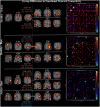Exploring the psychosis functional connectome: aberrant intrinsic networks in schizophrenia and bipolar disorder
- PMID: 22291663
- PMCID: PMC3254121
- DOI: 10.3389/fpsyt.2011.00075
Exploring the psychosis functional connectome: aberrant intrinsic networks in schizophrenia and bipolar disorder
Abstract
Intrinsic functional brain networks (INs) are regions showing temporal coherence with one another. These INs are present in the context of a task (as opposed to an undirected task such as rest), albeit modulated to a degree both spatially and temporally. Prominent networks include the default mode, attentional fronto-parietal, executive control, bilateral temporal lobe, and motor networks. The characterization of INs has recently gained considerable momentum, however; most previous studies evaluate only a small subset of the INs (e.g., default mode). In this paper we use independent component analysis to study INs decomposed from functional magnetic resonance imaging data collected in a large group of schizophrenia patients, healthy controls, and individuals with bipolar disorder, while performing an auditory oddball task. Schizophrenia and bipolar disorder share significant overlap in clinical symptoms, brain characteristics, and risk genes which motivates our goal of identifying whether functional imaging data can differentiate the two disorders. We tested for group differences in properties of all identified INs including spatial maps, spectra, and functional network connectivity. A small set of default mode, temporal lobe, and frontal networks with default mode regions appearing to play a key role in all comparisons. Bipolar subjects showed more prominent changes in ventromedial and prefrontal default mode regions whereas schizophrenia patients showed changes in posterior default mode regions. Anti-correlations between left parietal areas and dorsolateral prefrontal cortical areas were different in bipolar and schizophrenia patients and amplitude was significantly different from healthy controls in both patient groups. Patients exhibited similar frequency behavior across multiple networks with decreased low frequency power. In summary, a comprehensive analysis of INs reveals a key role for the default mode in both schizophrenia and bipolar disorder.
Keywords: ICA; connectivity; default mode network; fMRI; independent component analysis; intrinsic activity; networks.
Figures




References
-
- Allen E., Erhardt E., Damaraju E., Gruner W., Segall J., Silva R., Havlicek M., Rachakonda S., Fries J., Kalyanam R., Michael A., Turner J., Eichele T., Adelsheim S., Bryan A., Bustillo J. R., Clark V. P., Feldstein S., Filbey F. M., Ford C., Hutchison K., Jung R., Kiehl K. A., Kodituwakku P., Komesu Y., Mayer A. R., Pearlson G. D., Phillips J., Sadek J., Stevens M., Teuscher U., Thoma R. J., Calhoun V. D. (2011). A baseline for the multivariate comparison of resting state networks. Front. Hum. Neurosci. 1, 12 - PMC - PubMed
Grants and funding
LinkOut - more resources
Full Text Sources
Miscellaneous

